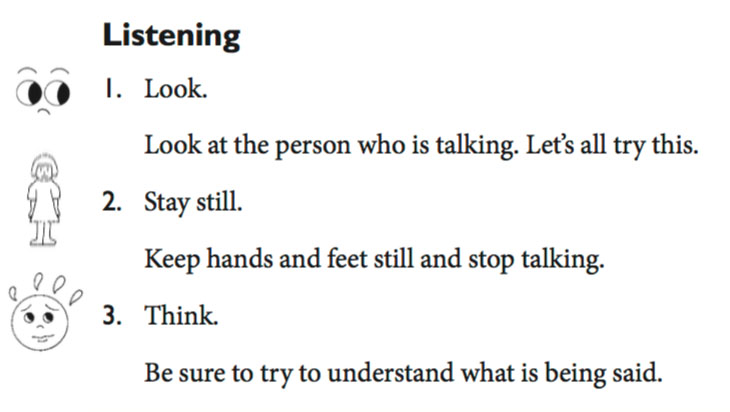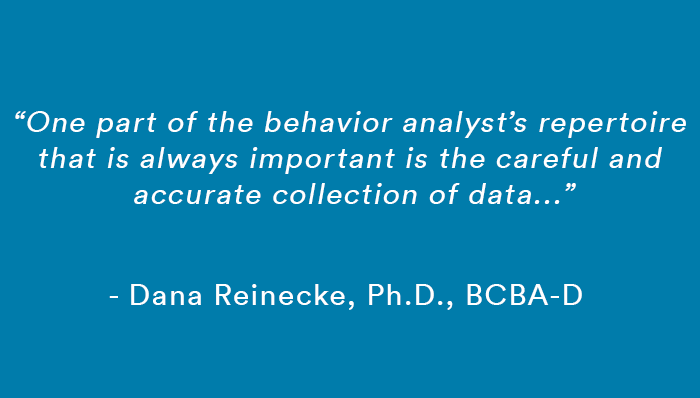One of the tenets of ABA is to provide evidence-based practice. The best way to help us do this is to keep up with the literature! Each month, Sam Blanco, PhD, LBA, BCBA will select one journal article and provide discussion questions for professionals working within the ABA community. The following week another ABA professional will respond to Sam’s questions and provide further insight and a different perspective on the piece.
- The researchers trained caregivers on a university campus using the BST model prior to home visits. In your current work, would this be a possibility for you? If not, how could you provide this type of training to caregivers? What obstacles can you predict, and how might you address them?
The
majority of my clinical practice is primarily situated in home-based
settings. Delivering behavior analytic
services in home-based settings presents with a multitude of circumstances contributing
to variable rates of success in teaching new skills for both the client and
caregivers. Two variables contributing
to such challenges in service delivery is caregiver accessibility and limited
service hours allotted, particularly if the services are funded through
insurance-based sources. Formal Behavior
Skills Training (BST) often requires time intensive performance and competency-
based components, creating a challenge to implement in the home setting at
times. With careful planning and caregiver commitment to participation, BST
training in the home setting is quite “do-able”.
To address time constraints, a ‘train the trainer’ model or pyramidal training (Pence, St. Peter, & Tetreault, 2012), may be a beneficial strategy to assist in training multiple caregivers as well as contribute to increased proficiency in treatment fidelity. A pyramidal training model involves a senior trainer (e.g., a behavior analyst) training a small group of staff or caregivers who in turn train other staff or caregivers. This type of training model may be particularly beneficial to clinicians working in settings where time constraints may be a factor (such as residential services).
- Discuss the multiple baseline design used in the study. How does it demonstrate experimental control? What can you determine from a visual analysis of the data?
The
researchers in this study utilized a concurrent
multiple-baseline-across-modules design to analyze the effects of the BST
module training delivered to parents to teach their children mands. Concurrent
multiple-baseline-across modules design allows for simultaneous
measurement to occur for all clients. Research suggests concurrent measurement
controls better for threats to internal validity and result in somewhat
stronger inferences than do nonconcurrent designs (Watson and Workman, 1981). Multiple
baseline designs are appropriate when target behaviors are not reversible. Use
of a concurrent multiple-baseline design to evaluate treatment effectiveness
minimizes the ethical concerns related to a withdrawal design. Training skills sequentially using a
multiple-baseline-across-modules design is beneficial since it allows trainers
to teach skills gradually and gave trainees repeated rehearsal opportunities on
previously trained skills. The trainer could also monitor ongoing caregiver
performance and make decisions to advance caregivers through the training based
on the consistency and accuracy of their performance on trained skills.
Researchers of the study required caregivers to reach specific mastery
criterion rates to advance to additional modules in the BST to assess the
maintenance of the caregiver’s accuracy of procedural integrity and the child’s
mands.
Upon visual analysis of the data, results
of the study support effects of a
BST model for training caregivers to implement mand training procedures. In addition, after training, caregivers did
not exhibit difficulties generalizing the skills to implement mand training
procedures to the child. Additional
training was provided to caregivers during sessions with the child when mastery
criterion was not achieved. The
researchers found by staggering the training across modules, caregivers learned
to capture and contrive motivating operations contributing to the emergence of spontaneous
mands.
- Part of this study included a measure of whether a competently trained parent could teach their spouse how to implement mand training. Why is this important? Have you implemented similar strategies in your own work?
Training
caregivers to effectively generalize behavior analytic treatment strategies and
interventions to the child outside of training sessions is one of the goals of family
support behavior analytic services. Strategies
to fade out the necessity of behavior analytic services is developed in the
client’s treatment plan at the initiation of services. Delivering
BST to a caregiver who demonstrates proficiency of the designated steps is
invaluable in the treatment process. Through
BST, trained caregivers who have
demonstrated mastery of a skill, have the ability to train additional
caregivers (e.g., grandparents and siblings) in the client’s environment, facilitating
generalization of treatment effects.
In
addition, research has supported the finding that providing caregivers with
training and education to increase their family member’s functional skills
(such as communication) may reduce caregiver stress by increasing the
caregiver’s confidence levels (Bebko et al. 1987). Researchers have
also found that parents who reported high levels of confidence in managing
their child’s major difficulties and perceived others in the family as similarly
successful also reported lower stress rates (Sharpley and Bitsika 1997).
In
my practice, I utilize BST to teach caregivers skills related to communication
and socialization training and areas of daily living such as toileting,
dressing, toothbrushing and community safety. I recently utilized BST to teach a modified
PECS (Picture Exchange Communication System) to a client’s caregivers. After reaching
fluency criteria for each step of the target skill, the trained caregiver was
capable of effectively training the modified PECS procedure to the second
caregiver. Success rates for each steps
of the BST procedure were measured by observation, data collection and data
analysis of procedural integrity demonstrated by the second parent during
sessions with the client. Success rates
were also measured by data analysis of
the client’s rate of progress in reaching various communication targets via use
of the modified PECS taught by caregivers.
- This study did include maintenance data. Why is this data valuable? Do you collect maintenance data on the caregiver training you provide?
According to Alberto & Troutman,
2013, ‘maintenance’ is defined as “performing a response over time, even after
systematic applied behavior procedures have been withdrawn”. Maintenance is demonstrated over time when the
skill continues to occur after all direct teaching of the particular skill has
been discontinued.
Maintenance
data could also be utilized to assist in shaping additional skills. For example, prior to teaching a client
receptive discrimination skills related to picture identification in a field of
3 stimuli, it is important to evaluate the presence or absence of certain prerequisite
skills such as attending, gesturing (i.e., pointing or eye gaze), following
direction and ability to identify objects depicted in the array. Without information gathered from maintenance
skill probes (i.e., attending, pointing, tact repertoire, etc.), teaching the
skill of receptive discrimination may not be possible if the client has not
exhibited mastery of specific prerequisite skills first.
During skill
acquisition training, I typically teach a targeted behavior until the recipient
exhibits fluency in exhibiting that behavior.
The computer- generated data system I utilize in my practice includes pre-set
monitoring schedules of maintenance data based upon a timed schedule. Maintenance probes are automatically
scheduled in a staggered fashion. For
example, if the client exhibits proficiency in engaging in a specific skill during
baseline, that skill is automatically scheduled for a maintenance probe on a
monthly basis. If a client reaches fluency
of a specific skill after commencement of treatment, the target is scheduled
for maintenance in a staggered time frame (i.e., weekly, bi-weekly, monthly,
bi-monthly and annually). After the client reaches mastery criterion for annual
maintenance, the target is considered ‘closed’. If at any time the target fails maintenance,
the target is added back into treatment.
If a clinician is
teaching skills to fluency, the necessity of relying on maintenance data to
determine if the skill remains in that client’s behavior repertoire becomes
less relevant.
- Consider a particular skill you are teaching one or more clients. What would BST look like to teach caregivers how to implement the necessary procedures for teaching that skill?
A particular skill BST could be
utilized to teach is use of utensils during mealtime.
Instruction – For this step, if a client exhibits adequate receptive skills related to
vocal/verbal instruction, one may say to the client, “When you eat certain
foods, such as spaghetti or vegetables, you use a fork to pick the food up. You
wouldn’t use a fork to eat foods such as cereal or pudding.”
If
the client does not exhibit adequate receptive language skills, one may
describe the skill to the caregiver. For
example: “We teach the skill of eating with utensils to assist with independent
functioning. We will practice this skill
first, with a fork and upon reach specific mastery criteria, we will proceed in
teaching use of additional utensils, such as a spoon. It’s best to practice this skill when
motivation to eat is high in order to increase rate of reinforcement and
eventually, acquisition of mastery criteria (i.e., if the client is hungry, his
motivation to follow the rule to use a fork to eat may be higher compared to
times when he is not hungry). Reinforcement for use of the fork is naturally
built in, as the food he eats with the fork will serve as reinforcement for the
targeted behavior.”
Along
with vocal/verbal instruction of the BST steps, I may also provide the
caregiver with written steps to the procedure to assist with fluency.
Modeling – For this step, during mealtime, I model the steps described above to the
caregiver. I provide a description of each
step as the step is being performed to the caregiver.
Rehearsal –For this step, encourage the caregiver to implement the steps to practice
the skill. During these practice
sessions, data recording is critical to determine fluency of the practice of
the targeted skill.
Feedback – Prior to this step, I discuss with the caregiver the form of feedback
they prefer to receive (in-situ feedback or feedback after each trial session
has ended). Throughout my career I have
learned the importance of tailoring my delivery of feedback to individual
preference (some caregivers prefer feedback while they are performing the step,
while others prefer to receive feedback after they have completed the
step). Once I have determined the timing
of my feedback, I deliver the feedback in the context agreed upon.
- The article states, “General instructions were provided prior to baseline, but parents were only able to implement the procedures effectively when full instructions, modeling, rehearsal and feedback were used to train to mastery.” How can you change your current practice to ensure that you are providing the necessary steps to help caregivers master skills they have selected for parent training?
To streamline the often time-intensive
process BST requires, I typically stagger the trainings across multiple
sessions. Delivery of insurance-based
family training services is generally provided in a time intensive and
structured fashion. To meet these stringent guidelines and to ensure I deliver
the most effective and efficient services, I provide the caregiver with written
and verbal steps to BST across several consecutive sessions. I review each step with the caregiver and
assign weekly assignments to practice specific steps. During each family training visit, I review
and model the steps and request the caregiver to perform the step they worked
on the week prior. After the caregivers reach
specific fluency rates in responding accurately, additional steps are introduced.
One method of training I may consider
including in my caregiver trainings when delivering BST, is use of video
modeling. Video modeling is a teaching procedure that involves an
individual viewing a videotaped sample of a model performing a specific,
scripted activity or task. Immediately following having viewed the video-based
model, the individual is directed to perform the activity or script he or she
observed in the video (e.g., MacDonald, Clark, Garrigan, & Vangala, 2005). Use of video modeling may further address time constraints
to training that is often a barrier in delivery of home-based services. Video modeling may also assist in in higher
rates of procedural integrity when working with caregivers who learn more
effectively through use of visual guides as opposed to textual guides only.
BST is an incredibly invaluable method of
teaching new skills. With careful
planning and commitment to learning, caregivers have a unique opportunity to actively
participate in their family member’s treatment to help them engage in socially
meaningful ways.
References
Alberto, P., & Troutman, A. C. (2013). Applied
behavior analysis for teachers. Boston: Pearson.
Bebko JM, Konstantareas MM,
Springer J. Parent and professional evaluations of family stress associated
with characteristics of autism. Journal of Autism and Developmental
Disorders. 1987; 17:565–576.
MacDonald, R., Clark, M., Garrigan, E., &Vangala, M.
(2005) Using video modeling to teach pretend play to children with
autism. Behavioral Interventions, 20, 225-238.
Parsons M. B., Rollyson J.
H., Reid D. H. Evidence-based staff training: A guide for practitioners. Behavior
Analysis in Practice. 2012; 5:2–11.
Parsons, M. B., Rollyson, J. H., & Reid, D. H. (2013).
Teaching Practitioners to Conduct Behavioral Skills Training: A Pyramidal
Approach for Training Multiple Human Service Staff. Behavior analysis
in practice, 6(2), 4–16. doi:10.1007/BF03391798.
Pence S. T., St.
Peter C. C., Tetreault A. S. Increasing accurate preference assessment
implementation through pyramidal training. Journal
of Applied Behavior Analysis. 2012;45:345–359.
Sharpley, C. F., &
Bitsika, V. (1997). Influence of gender, parental health, and perceived expertise
of assistance upon stress, anxiety, and depression among parents of children
with autism. Journal of Intellectual and Developmental Disability, 22,
19–29.
Watson, Paul & A. Workman, Edward. (1981). The non-concurrent multiple baseline across-individuals design: An extension of the traditional multiple baseline design. Journal of behavior therapy and experimental psychiatry. 12. 257-9.
Elizabeth A. Drago, M.A., BCBA, LBA, is a Board Certified and Licensed Behavior Analyst and a consultant at Proud Moments Therapy located on Long Island, New York and Comprehensive Behavior Supports, located in Brooklyn, NY. She has over 15 years’ experience working with individuals with developmental and related disabilities and has advanced training in areas of autism, behavior disorders, sleep disorders, intellectual disabilities and positive behavior supports. As a consultant in home and educational settings, she clinically oversees client cases, provides parent training, implements comprehensive skill assessments and programming goals for children diagnosed with ASD, conducts staff trainings for effective performance improvement practices and behavior analytic practices and procedures. She holds professional memberships in organizations such as New York State Association for Applied Behavior Analysis, Association for Behavior Analysis International, Association of Professional Behavior Analysis.
Elizabeth is a Board member of the New York State
Association for Behavior Analysis (NYSABA), serving the role of Representative
at Large. She is also an active member of NYSABA’s Legislative Committee,
focusing on efforts to remove the licensure scope of practice restriction in
Behavior Analysis in New York State. Elizabeth has contributed significantly to
disseminating information related to the scope restriction in Behavior Analysis
in NYS. Some of Elizabeth’s achievements in these efforts include developing
initiatives such as the video series entitled, ‘This is ABA’. The purpose of the video series is to
highlight the effectiveness and applicability of the practice of Behavior
Analysis to individuals of varying diagnoses, not only for those diagnosed with
an Autism Spectrum Disorder. This video series is currently featured on the
NYSABA website. Elizabeth also works collaboratively with
NYSABA’s Executive Director, Mari Wantanbe-Rose in the development and
oversight of NYSABA’s Inaugural ABA Ambassador Award. The NYSABA ABA Ambassador
Award recognizes future behavior analysts, or students, who help to disseminate
the usefulness and versatility of behavior analysis in various settings.
Elizabeth has presented at NYSABA’s annual professional conference on the topics of Systematic Desensitization (2017) and Self-Care for the Behavior Analyst (2018). She has been invited as a speaker at a roundtable meeting at Proud Moments ABA, presenting on the topic of the use of technical jargon when interacting with caregivers. Elizabeth has also been featured in a newsletter (August 2018 edition) generated by Comprehensive Behavior Supports in recognition of the many significant contributions to the agency and families she serves across Long Island as a Licensed and Board Certified Behavior Analyst. Elizabeth has been a guest speaker on a Behavior Analytic podcase, ‘Behaviorbabe’, hosted by Dr. Amanda Kelly, discussing the NYS licensure law scope restriction on the practice of Behavior Analysis in NYS. Elizabeth received a Bachelor’s Degree in Clinical Psychology from St. John’s University, graduating Summa Cum Laude. She continued her education, earning her Master’s Degree in Clinical Psychology at Teacher’s College, Columbia University, where she received an honors certificate in education and teaching and was a member of Kappa Delta Phi- Honor Society in Education. Elizabeth attended post-graduate studies at Penn State University, where she completed coursework in Applied Behavior Analysis. She earned her BCBA certification and licensure in Behavior Analysis in 2014.



